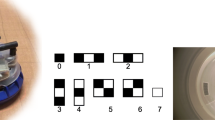Abstract
In evolutionary robotics, the mapping from raw sensory input to neural network input is typically decided by the experimenter or encoded in the genome. Either way, the mapping remains fixed throughout a robot’s lifetime. Inspired by biological sensory organs and the mammalian brain’s capacity for selective attention, we evaluate an alternative approach in which a robot has active, real-time control over the mapping from sensory input to neural network input. We augment the neural controllers with additional output neurons that control key sensory parameters and evolve solutions for a single-robot foraging task. The results show that the capacity to control the mapping from raw input to neural network input is exploited by evolution and leads to novel solutions with higher fitness compared to traditional approaches.
Access this chapter
Tax calculation will be finalised at checkout
Purchases are for personal use only
Preview
Unable to display preview. Download preview PDF.
Similar content being viewed by others
References
Ampatzis, C., Tuci, E., Trianni, V., Christensen, A.L., Dorigo, M.: Evolving self-assembly in autonomous homogeneous robots: experiments with two physical robots. Artificial Life 15(4), 465–484 (2009)
Auerbach, J.E., Bongard, J.C.: On the relationship between environmental and mechanical complexity in evolved robots. In: International Conference on Artificial Life (ALIFE), pp. 309–316. MIT Press, Cambridge (2012)
Balakrishnan, K., Honavar, V.: On sensor evolution in robotics. In: Annual Conference on Genetic Programming, pp. 455–460. MIT Press, Cambridge (1996)
Beer, R.D., Gallagher, J.C.: Evolving dynamical neural networks for adaptive behavior. Adaptive Behavior 1, 91–122 (1992)
Bellman, R.: Dynamic Programming, 1st edn. Princeton University Press, Princeton (1957)
Dorigo, M., Floreano, D., Gambardella, L.M., Mondada, F., Nolfi, S., Baaboura, T., Birattari, M., Bonani, M., Brambilla, M., Brutschy, A., et al.: Swarmanoid: a novel concept for the study of heterogeneous robotic swarms. IEEE Robotics & Automation Magazine 20(4), 60–71 (2013)
Floreano, D., Dürr, P., Mattiussi, C.: Neuroevolution: from architectures to learning. Evolutionary Intelligence 1(1), 47–62 (2008)
Floreano, D., Mondada, F.: Evolutionary neurocontrollers for autonomous mobile robots. Neural Networks 11(7–8), 1461–1478 (1998)
Fries, P., Reynolds, J.H., Rorie, A.E., Desimone, R.: Modulation of oscillatory neuronal synchronization by selective visual attention. Science 291(5508), 1560–1563 (2001)
Groot, S.G.D., Gebhard, J.W.: Pupil size as determined by adapting luminance. Journal of the Optical Society of America 42(7), 492–495 (1952)
Hess, E.H., Polt, J.M.: Pupil size as related to interest value of visual stimuli. Science 132(3423), 349–350 (1960)
Kam-Chuen, J., Giles, C., Horne, B.: An analysis of noise in recurrent neural networks: convergence and generalization. IEEE Transactions on Neural Networks 7(6), 1424–1438 (1996)
Lipson, H., Pollack, J.B.: Automatic design and manufacture of robotic lifeforms. Nature 406(6799), 974–978 (2000)
Lund, H., Hallam, J., Lee, W.-P.: Evolving robot morphology. In: IEEE International Conference on Evolutionary Computation, pp. 197–202. IEEE Press, Piscataway (1997)
Mark, A., Mark, R., Polani, D., Uthmann, T.: A framework for sensor evolution in a population of braitenberg vehicle-like agents. In: International Conference on Artificial Life (ALIFE), pp. 428–432. MIT Press, Cambridge (1998)
Mautner, C., Belew, R.K.: Evolving robot morphology and control. Artificial Life and Robotics 4(3), 130–136 (2000)
Meyer, J.-A., Husbands, P., Harvey, I.: Evolutionary robotics: A survey of applications and problems. In: 1st European Workshop on Evolutionary Robotics (EvoRobot), pp. 1–21. Springer, Berlin (1998)
Mondada, F., Guignard, A., Bonani, M., Bär, D., Lauria, M., Floreano, D.: Swarm-bot: From concept to implementation. In: IEEE/RSJ International Conference on Intelligent Robots and Systems, pp. 1626–1631. IEEE Press, Piscataway (2003)
Nolfi, S., Floreano, D.: Learning and evolution. Autonomous Robots 7(1), 89–113 (1999)
Nolfi, S., Floreano, D.: Evolutionary robotics: The biology, intelligence, and technology of self-organizing machines. MIT Press, Cambridge (2000)
Parker, G., Nathan, P.: Concurrently evolving sensor morphology and control for a hexapod robot. In: IEEE Congress on Evolutionary Computation (CEC), pp. 1–6. IEEE Press, Piscataway (2010)
Silva, F., Urbano, P., Oliveira, S., Christensen, A.L.: odNEAT: An algorithm for distributed online, onboard evolution of robot behaviours. In: International Conference on Simulation and Synthesis of Living Systems (ALIFE), pp. 251–258. MIT Press, Cambridge (2012)
Soltoggio, A., Bullinaria, J.A., Mattiussi, C., Dürr, P., Floreano, D.: Evolutionary advantages of neuromodulated plasticity in dynamic, reward-based scenarios. In: International Conference on the Simulation and Synthesis of Living Systems (ALIFE), pp. 569–576. MIT Press, Cambridge (2008)
Watson, R., Ficici, S., Pollack, J.: Embodied evolution: Embodying an evolutionary algorithm in a population of robots. In: IEEE Congress on Evolutionary Computation (CEC), pp. 335–342. IEEE Press, Piscataway (1999)
Young, E.D., Rice, J.J., Tong, S.C.: Effects of pinna position on head-related transfer functions in the cat. Journal of the Acoustical Society of America 99(5), 3064–3076 (1996)
Duarte, M., Sliva, F., Rodrigues, T., Oliveria, S.M., Christensen, A.L.: JBotEvolver: A Versatile Simulation Platform for Evolutionary Robotics. Proceedings of the International Conference on the Synthesis and Simulation of Living System (ALIFE), pp. 210–211. MIT Press, Cambridge, MA (2014)
Zhang, Y., Martinoli, A., Antonsson, E.K.: Evolutionary design of a collective sensory system. In: AAAI Spring Symposium on Computational Synthesis, pp. 283–290. MIT Press, Cambridge (2003)
Author information
Authors and Affiliations
Corresponding author
Editor information
Editors and Affiliations
Rights and permissions
Copyright information
© 2014 Springer-Verlag Berlin Heidelberg
About this paper
Cite this paper
Rodrigues, T., Duarte, M., Oliveira, S., Christensen, A.L. (2014). What You Choose to See Is What You Get: An Experiment with Learnt Sensory Modulation in a Robotic Foraging Task. In: Esparcia-Alcázar, A., Mora, A. (eds) Applications of Evolutionary Computation. EvoApplications 2014. Lecture Notes in Computer Science(), vol 8602. Springer, Berlin, Heidelberg. https://doi.org/10.1007/978-3-662-45523-4_64
Download citation
DOI: https://doi.org/10.1007/978-3-662-45523-4_64
Published:
Publisher Name: Springer, Berlin, Heidelberg
Print ISBN: 978-3-662-45522-7
Online ISBN: 978-3-662-45523-4
eBook Packages: Computer ScienceComputer Science (R0)




